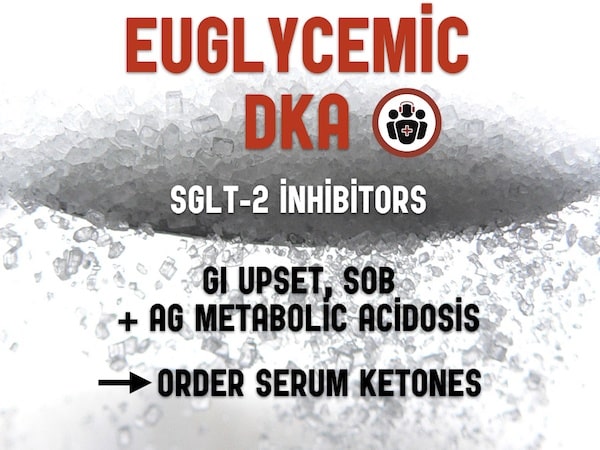This is EM Cases Best Case Ever 58 – Euglycemic DKA with Walter Himmel, the walking encyclopedia of emergency medicine. It’s not only run of the mill DKA, starvation and alcoholic ketoacidosis that can cause a metabolic acidosis with elevated ketones. Euglycemic DKA can be caused by the newer diabetes medications sodium-glucose co-transporter 2 inhibitors like Canagliflozin; and it’s important to recognize this tricky diagnosis early and initiate treatment for DKA despite a normal serum glucose level, because DKA can lead to serious complications like renal failure, cerebral edema, ARDS, shock, and death.
Podcast production, sound design and editing by Anton Helman;
Written by Anton Helman, June 2017
Euglycemic DKA can occur in any diabetic and has been reported in the literature since the 1970’s, but there has recently been a rise in incidence of euglycemic DKA associated with sodium-glucose co-transporter 2 inhibitors (SGLT-2 inhibitors, or the “zins”) such as Canagliflozin, Dapagliflozin and Empagliflozin.
When to suspect euglycemic DKA
Any patient with Type 1 or 2 diabetes taking SGLT-2 inhibitors who presents with nausea, vomiting, SOB or malaise or is found to have a metabolic acidosis should have blood drawn for serum ketones.
Triggers of euglycemic DKA are similar to the triggers for any DKA: Alcohol use, infection and reduced oral intake.
Distinguishing euglycemic DKA from alcoholic DKA
Alcoholic ketoacidosis may also present with nausea, vomiting, malaise, ketones and anion gap metabolic acidosis. The key differentiating factor besides the obvious history of heavy alcohol use vs a diabetic taking an SGLT-2 inhibitor, is that patients with alcoholic ketoacidosis tend to have frankly low glucose.
How is treatment of euglycemic DKA different?
In addition to balanced crystalloids, you may need to start fluids with dextrose sooner in the treatment process, as the serum blood glucose is already low.
Take home message for euglycemic DKA
Obtain serum ketones in all patients with anion gap metabolic acidosis and all diabetic patients taking an SGLT-2 inhibitor who present with nausea, vomiting or shortness of breath.
Drs. Helman and Himmel have no conflicts of interest to declare
References
Peters AL, Buschur EO, Buse JB, Cohan P, Diner JC, Hirsch IB. Euglycemic Diabetic Ketoacidosis: A Potential Complication of Treatment With Sodium-Glucose Cotransporter 2 Inhibition. Diabetes Care. 2015;38(9):1687-93.
Jazi M, Porfiris G. Euglycemic diabetic ketoacidosis in type 2 diabetes treated with a sodium-glucose cotransporter-2 inhibitor. Can Fam Physician. 2016;62(9):722-4.
Munro JF, Campbell IW, McCuish AC, Duncan LJP. Euglycaemic diabetic ketoacidosis. BMJ 1973;2:578–580
FDA Drug Safety Communication. FDA warns that SGLT2 inhibitors for diabetes may result in a serious condition of too much acid in the blood. Available from http://www.fda.gov/Drugs/DrugSafety/ucm446845.htm?source=govdelivery&utm_medium=email&utm_source=govdelivery.
Hine J, Paterson H, Abrol E, Russell-jones D, Herring R. SGLT inhibition and euglycaemic diabetic ketoacidosis. Lancet Diabetes Endocrinol. 2015;3(7):503-4.
Rosenstock J, et al. Euglycemic Diabetic Ketoacidosis: A Predictable, Detectable, and Preventable Safety Concern With SGLT2 Inhibitors. Diabetes Care. 2015 Sep;38(9):1638-42





Leave A Comment